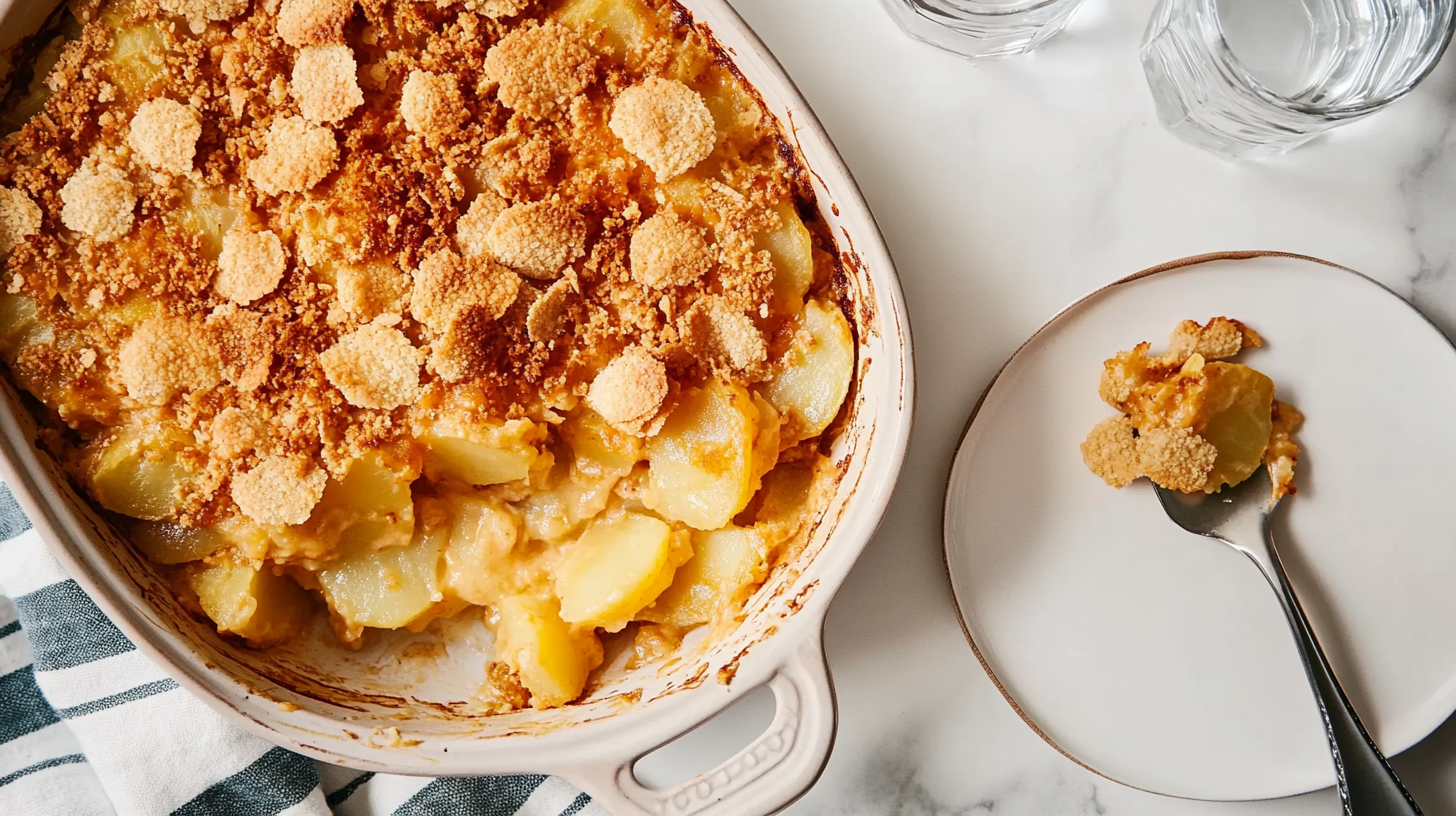Pineapple casserole is a dish that surprises and delights with its distinctive combination of sweet and savory flavors. This Southern classic, often served during holiday meals and special gatherings, highlights the unique pairing of pineapple, cheese, and a buttery cracker topping.
The pineapple casserole balances simplicity and sophistication, making it a versatile addition to any table. Whether you’re a fan of traditional recipes or enjoy experimenting with new twists, this dish has something to offer. It’s also a crowd-pleaser, ideal for potlucks, barbecues, and festive dinners. As you dive into this guide, you’ll discover the origins, ingredients, variations, and secrets to preparing the perfect pineapple casserole. With the right techniques and a touch of creativity, you’ll master a recipe that stands out for its taste and texture.
Table of Contents
What is Pineapple Casserole?
At its core, pineapple casserole is a baked dish that merges canned pineapple chunks, shredded cheese, and a sweet-and-savory crumb topping. While it might sound unconventional, this combination creates a delightful medley of flavors. Some argue that it’s a side dish, while others enjoy it as a dessert. The versatility of pineapple casserole is one of its defining characteristics. Its origins are deeply rooted in Southern cuisine, where creativity with ingredients is celebrated.
The sweetness of the pineapple contrasts beautifully with the tangy cheese and crunchy topping, offering a sensory experience unlike any other. As with many regional dishes, this casserole has evolved over time, with different families adding their personal touches. Regardless of the variation, pineapple casserole remains a testament to the ingenuity of home cooks who transform simple ingredients into memorable meals.
Creative Toppings for Pineapple Casserole
The topping is a defining feature of pineapple casserole, and there’s plenty of room for creativity to make it even more delicious. While the traditional cracker and butter topping is beloved for its crunch and richness, adding other ingredients can elevate the dish’s texture and flavor profile. Crushed nuts, such as pecans or walnuts, bring a nutty, earthy contrast that pairs beautifully with the sweetness of the pineapple. Another option is caramelized brown sugar, which adds a deep, molasses-like sweetness and a slightly sticky texture when baked.
For an extra crunch, consider mixing oats or granola into the topping. If you’re feeling adventurous, a sprinkle of shredded coconut can introduce a tropical flair, while a pinch of cinnamon or nutmeg adds warmth and complexity. These creative toppings can be layered on their own or combined with the traditional ingredients to create a signature twist on your pineapple casserole. Experimenting with these options allows you to personalize the dish while delighting your guests with new textures and flavors.
How to Make Pineapple Casserole Ahead of Time
Preparing pineapple casserole ahead of time is a great way to reduce stress during busy occasions or large gatherings. To make it in advance, assemble the casserole as you normally would, but stop before baking it. Cover the dish tightly with plastic wrap or aluminum foil and store it in the refrigerator for up to 24 hours. This method allows the flavors to meld together, enhancing the overall taste once it’s baked.
If you’re planning to freeze the dish, it’s best to keep the topping separate until you’re ready to bake. Freezing can soften crackers and other toppings, which might compromise the dish’s signature crunch. When you’re ready to bake, simply sprinkle the topping over the casserole and bake it straight from the fridge or after it has thawed. To maintain the freshness of the pineapple and the texture of the casserole, avoid leaving it assembled for more than a day before baking. These steps ensure that your pineapple casserole retains its taste, texture, and charm, even when prepared in advance.
Ingredients for Pineapple Casserole
The ingredient list for a classic pineapple casserole is refreshingly straightforward. Here’s what you’ll need for the base recipe:
- Pineapple: Canned pineapple chunks or tidbits work best. Reserve the juice for added flavor.
- Cheese: Shredded cheddar cheese is the traditional choice, offering a sharp, tangy note.
- Crackers: Butter crackers like Ritz add a buttery crunch.
- Butter: Melted butter is essential for the topping’s texture.
- Sugar: Granulated sugar enhances the sweetness of the pineapple.

Optional ingredients can include:
- Nuts: Chopped pecans or walnuts for added crunch.
- Cinnamon or Nutmeg: For a hint of warm spice.
The beauty of pineapple casserole lies in its adaptability, allowing you to tweak the ingredients to suit your preferences. With just a handful of pantry staples, you can create a dish that feels both comforting and special.
The History of Pineapple Casserole
The origins of pineapple casserole are often traced back to the American South, where cooks have a history of blending unlikely ingredients into delicious creations. Pineapples, once considered a symbol of hospitality, were a prized ingredient in Southern kitchens. Over time, home cooks began incorporating canned pineapple into their recipes, giving rise to unique dishes like pineapple casserole.
The dish became particularly popular in the mid-20th century, as convenience foods like canned fruit and packaged crackers gained popularity. It was embraced for its simplicity, flavor, and ability to feed a crowd. While the exact inventor of pineapple casserole remains unknown, its enduring appeal speaks to the creativity and resourcefulness of those who brought it to life. Today, this casserole is a staple at holiday gatherings, potlucks, and family dinners, continuing to unite generations around the table.
Why is Pineapple Casserole Popular?
The enduring popularity of pineapple casserole can be attributed to its unique flavor profile and versatility. The dish strikes a perfect balance between sweet and savory, making it suitable for a variety of occasions. Its widespread appeal lies in the way it complements both main courses like ham or roasted chicken and desserts like fruit salads. Another reason for its popularity is its ease of preparation. Even novice cooks can achieve great results with minimal effort.
Furthermore, pineapple casserole evokes a sense of nostalgia, often associated with cherished family traditions and gatherings. This dish also adapts well to different dietary needs, which has helped it remain relevant in modern kitchens. Whether served as a side dish or a dessert, pineapple casserole is a recipe that brings joy to the table.
Step-by-Step Pineapple Casserole Recipe
Preparing a pineapple casserole is straightforward and rewarding. Follow these steps for a perfect result:
- Preheat your oven: Set it to 350°F (175°C).
- Prepare the pineapple mixture: In a bowl, combine drained pineapple chunks, reserved juice, shredded cheddar cheese, and sugar. Mix well.
- Make the topping: Crush the crackers and mix them with melted butter until evenly coated.
- Assemble the casserole: Spread the pineapple mixture into a greased baking dish, and evenly distribute the cracker topping over it.
- Bake: Place the dish in the preheated oven and bake for 25–30 minutes, or until the topping is golden and bubbly.
Cooking tips:
- Don’t overbake, as this can dry out the casserole.
- Let the casserole rest for a few minutes before serving to allow the flavors to meld.
With these steps, you’ll have a delightful pineapple casserole ready to impress your family and friends.
Nutritional Insights
While pineapple casserole is undeniably indulgent, it also offers some nutritional benefits. Pineapples are a rich source of vitamin C, manganese, and antioxidants, which support immune health and reduce inflammation. However, the dish’s calorie content largely depends on the amount of sugar, cheese, and butter used. For those watching their calorie intake, small adjustments like reducing sugar or opting for low-fat cheese can make a difference. Additionally, serving sizes play a key role in managing nutritional impact. Moderation allows you to enjoy the comforting flavors of pineapple casserole while maintaining a balanced diet.
Variations of Pineapple Casserole
One of the best aspects of pineapple casserole is its adaptability. Here are a few popular variations:
- Gluten-Free: Use gluten-free crackers or breadcrumbs for the topping.
- Vegan: Replace cheese with a plant-based alternative and butter with vegan margarine.
- Nutty Twist: Add chopped pecans or walnuts to the topping for added crunch.
- Spiced: Sprinkle cinnamon or nutmeg into the pineapple mixture for a warm, festive flavor.
These variations ensure that everyone at the table can enjoy a dish tailored to their preferences.
Serving Suggestions
Pineapple casserole pairs beautifully with a range of dishes. Here are some ideas:
- Serve as a side dish with glazed ham, roasted turkey, or grilled chicken.
- Offer it as a dessert alongside vanilla ice cream or whipped cream.
- Present it at potlucks or holiday buffets as a crowd-pleasing option.
Common Mistakes to Avoid
To achieve the best results with your pineapple casserole, avoid these common pitfalls:
- Using too much juice: Drain the pineapple well to prevent the casserole from becoming watery.
- Overbaking: Monitor the baking time to avoid a dry, overcooked dish.
- Skimping on the topping: A generous cracker topping is essential for the perfect texture and flavor balance.
By keeping these tips in mind, you’ll create a pineapple casserole that’s consistently delicious.
Pineapple Casserole for Special Occasions
Pineapple casserole shines during holidays and festive gatherings. Its vibrant flavor and golden appearance make it a standout dish on any table. During Thanksgiving or Christmas, it pairs wonderfully with traditional entrees like turkey or ham. It’s also a popular choice for Easter brunches, summer barbecues, and potlucks. The dish’s versatility allows it to fit seamlessly into menus for various occasions, making it a reliable go-to recipe.
Storing and Reheating Pineapple Casserole
To store leftover pineapple casserole, cover the dish tightly with plastic wrap or transfer it to an airtight container. Refrigerate for up to three days. For longer storage, freeze the casserole in a freezer-safe container for up to three months. When reheating, preheat your oven to 325°F (165°C) and warm the casserole until heated through. Avoid using the microwave, as it can make the topping soggy.
FAQs
What cheese goes well with pineapple?
Cheddar cheese is the most popular choice when pairing cheese with pineapple, especially in dishes like pineapple casserole. Its sharp and tangy flavor balances the sweetness of the pineapple, creating a delightful contrast. Other options include Monterey Jack or mozzarella for a milder taste, or blue cheese for a bold and complex flavor. The type of cheese you choose depends on your personal preferences and the specific dish you’re preparing, but cheddar remains the classic option for its rich, complementary profile.
Can I use fresh pineapple instead of canned?
Yes, you can use fresh pineapple instead of canned in recipes, but there are a few adjustments to consider. Fresh pineapple tends to be less sweet and more fibrous than canned, so you may need to add extra sugar to achieve the desired sweetness. Additionally, fresh pineapple releases less juice than canned, so you might need to add a splash of pineapple juice or water to maintain the casserole’s texture. Make sure to cut the pineapple into small, uniform pieces to ensure even baking.
What does pineapple do in baking?
Pineapple adds moisture, natural sweetness, and a bright, tangy flavor to baked goods. Its juice can enhance the texture of cakes, muffins, and breads by keeping them soft and tender. The acidity of pineapple also acts as a tenderizer for batters and doughs, making baked items more delicate and flavorful. In some cases, pineapple contributes a caramelized, slightly tangy note when baked, adding depth to the overall taste.
Why do you put milk and pineapple together?
Combining milk and pineapple in recipes creates a creamy, tropical flavor that enhances the dish’s richness. This pairing is commonly found in desserts, smoothies, and certain casseroles. However, it’s important to blend the ingredients properly, as fresh pineapple contains an enzyme called bromelain that can curdle milk if not cooked or neutralized. When prepared correctly, the creamy texture of milk complements the fruity brightness of pineapple, making it a delightful combination in sweet and savory recipes.
Recipe Suggestions
To create a balanced and satisfying lunch, pair your Cajun Shrimp Pasta with our Pineapple Casserole recipe for a comforting side dish. Looking for something lighter? Try our Grilled Chicken Wrap, which provides a refreshing contrast to the bold, spicy flavors of the pasta.
Conclusion
Pineapple casserole is a timeless dish that continues to charm with its unique blend of flavors and textures. Whether you’re preparing it for a family lunch or a festive occasion, it’s a recipe that brings warmth and joy to any table. With the tips and variations provided, you’ll master the art of creating a pineapple casserole that suits your taste and wows your guests.


